Fig. 68.1
Knee joint area (Reproduced with permission from Danilo Jankovic)
Ligaments in the Knee Joint [3, 7]
The stability of the knee is mainly maintained by various knee ligaments. The patellar ligament is a continuation of the quadriceps ligament and passes from the patella to the tibial tuberosity. The lateral patellar retinaculum is formed from fibers of the vastus lateralis and rectus femoris muscles, and fibers from the iliotibial tract also radiate into it. The medial patellar retinaculum mainly arises from fibers from the vastus medialis (Figs. 68.2 and 68.3).
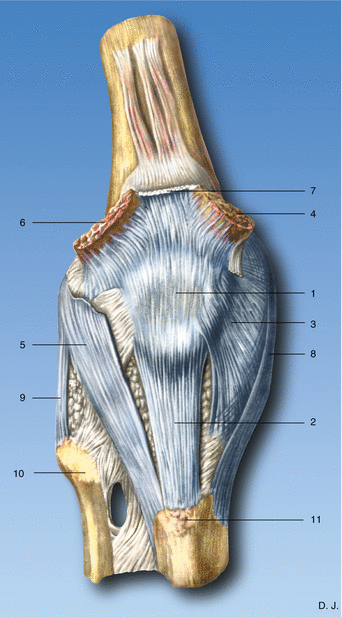
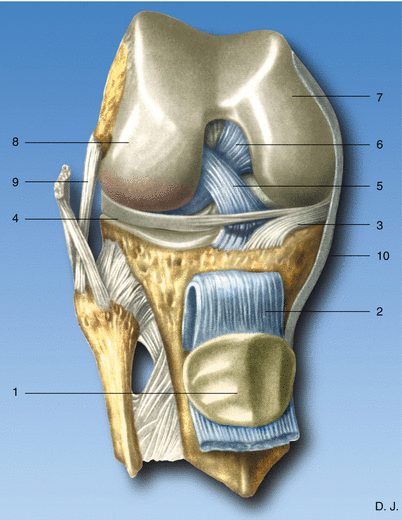

Fig. 68.2
(1) Patella, (2) ligamentum patellae, (3) medial patellar retinaculum, (4) vastus medialis muscle, (5) lateral patellar retinaculum, (6) vastus lateralis muscle, (7) tendon of the rectus femoris muscle, (8) tibial collateral ligament, (9) fibular collateral ligament, (10) head of fibula, (11) tibial tubercle (Reproduced with permission from Danilo Jankovic)

Fig. 68.3
(1) Articular surface of the patella, (2) ligamentum patellae, (3) medial meniscus, (4) lateral meniscus, (5) anterior cruciate ligament, (6) posterior cruciate ligament, (7) medial epicondyle, (8) lateral epicondyle, (9) fibular collateral ligament (lateral ligament), (10) tibial collateral ligament (lateral ligament) (Reproduced with permission from Danilo Jankovic)
The collateral ligaments prevent overextension of the knee joint, as well as abduction and adduction. The broad collateral tibial ligament stretches between the medial condyles of the femur and the tibia and is firmly adherent to the medial meniscus. The round fibular collateral ligament is not firmly attached to the joint capsule (Figs. 68.2 and 68.3).
The cruciate ligaments (anterior and posterior) serve to maintain contact during rotational movements (Figs. 68.2 and 68.3). The menisci (lateral and medial) consist of connective tissue with abundant collagenous fibrous material and embedded cartilage-like cells (Fig. 68.3).
The infrapatellar fat pad (Hoffa’s fat pad) forms the anterior part of the medial septum, which together with the infrapatellar synovial plica and cruciate ligaments separates the femorotibial joints from one another. From the medial and lateral margin of the articular surface of the patella, the synovial membrane forms twofold — the alar folds – which project inside the joint and cover the fat pad (Fig. 68.4).
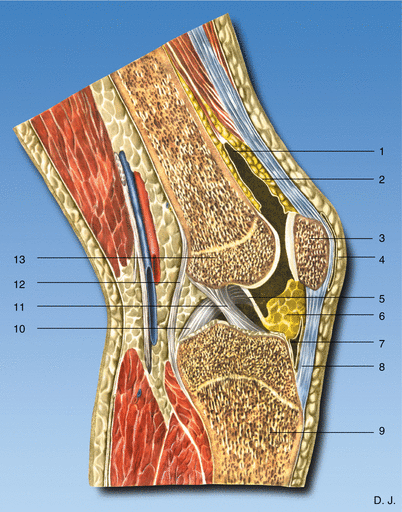

Fig. 68.4
(1) Suprapatellar bursa, (2) corpus adiposum suprapatellare, (3) patella, (4) prepatellar bursa, (5) synovial fold, (6) infrapatellar fat pad (Hoffa’s fat pad), (7) infrapatellar bursa, (8) ligamentum patellae, (9) tibia, (10) posterior cruciate ligament, (11) anterior cruciate ligament, (12) articular capsule, (13) lateral epicondyle (Reproduced with permission from Danilo Jankovic)
Vascular Supply and Innervation of the Knee Joint [7]
The vascular anastomosis for the knee joint is formed by the terminal branches of ten vessels:
From above: from the lateral circumflex femoral artery (descending branch) and the descending genicular artery from the femoral artery.
At the level of the joint: five branches are contributed from the popliteal artery.
From below: three branches of leg arteries, from the anterior and posterior tibial arteries and from the fibular artery.
The above arteries are accompanied by the veins with the same names (Fig. 68.5a–d).
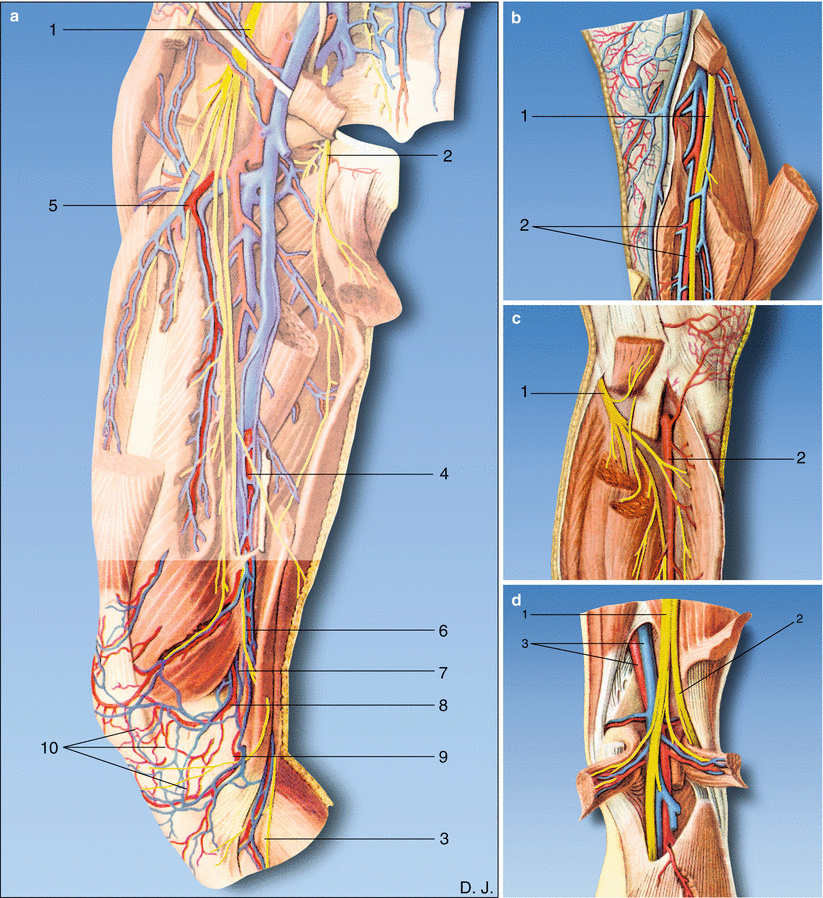

Fig. 68.5
(a–d) Vascular supply and innervation of the knee joint. (a) Anterior view. (1) Femoral nerve, (2) obturator nerve, (3) saphenous nerve, (4) femoral artery, (5) lateral femoral circumflex artery(descending branch), (6) descending genicular artery, (7) articular branch, (8) superior medial genicular artery, (9) inferior medial genicular artery, (10) rete patellae. (b) Medial view. (1) Tibial nerve, (2) posterior tibial artery and vein. (c) Antero-lateral view. (1) Common peroneal (fibular) nerve, (2) anterior tibial artery. (d) Popliteal fossa. (1) Tibial nerve, (2) common peroneal (fibular) nerve, (3) popliteal artery and vein (Reproduced with permission from Danilo Jankovic)
The innervation of the knee joint is provided by numerous nerves: joint branches from the femoral nerve reach the knee via neural branches supplying the vastus muscles and via the saphenous nerve, via articular branches from the posterior branch of the obturator nerve, and via articular branches from the sciatic nerve (tibial and common fibular [peroneal] nerves) (Figs. 68.5a–d and 68.6).
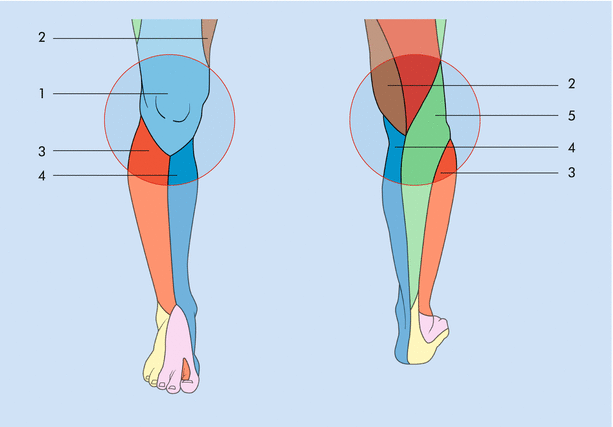

Fig. 68.6



Knee joint. Cutaneous innervation area. (1) Femoral nerve, (2) obturator nerve, (3) common peroneal (fibular) nerve, (4) saphenous nerve, (5) tibial nerve (Reproduced with permission from Danilo Jankovic)

Full access? Get Clinical Tree








